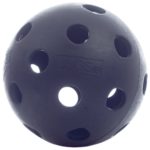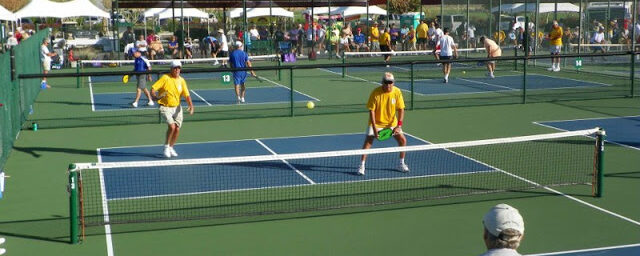
5 Reasons Why Pickleball is The Next Big Thing in Sports!
Pickleball has gained some serious strides in the past few years. All of a sudden, It has become the fastest growing racquet sport in the United States. No doubt in the next 10 years or so, this sport will get even more popular. In short, Pickleball still has a lot of room to grow. And if everything falls into place, this racquet sports will soon explode outside the US with more pickleball communities beginning to sprout in other countries.
Sure, there are many factors that have contributed to the sport’s rapid growth. However, these five reasons would probably sum up why pickleball is so darn addicting.
It’s easy to learn – Again, what makes pickleball so appealing is it isn’t complicated to play. You can fall in love with the sport in your first try without prior knowledge of the game. Pickleball’s striking similarity to more popular racquet sports like tennis and badminton allows beginners to pick up the game’s fundamentals right away. With just a few more tips from your coach, competing in your very first Pickleball tournament the next week wouldn’t be a surprising feat at all.
It’s a finesse sport – Whether you are already past your prime or just a new kid on the block, pickleball proves to be a sport for everybody. The thing is pickleball is a finesse sport at its core. Power has never been its premium. As a matter of fact, pickleball tournaments are often won by players in their late 50s and 60s. It only shows that age is just a number in this sport.
Don’t get me wrong, it’s always a good thing if you are a born athlete. However, being athletically-gifted won’t guarantee success in pickleball. Here, it’s all about ball control, anticipation and the knack of finding gaps on the opposite side of the court. These are the skills that will make you a winner.
It’s cheap – Compared to tennis, pickleball is a lot cheaper. Let’s be honest, you probably have to spend at least $300 for a durable tennis racket and a few more dollars to cover the yearly membership fee at a tennis club near you.
On the other hand, most outdoor pickleball courts are open to the public and free to use. A good wooden pickleball paddle can go as cheap as $13 while a graphite paddle just costs between $60 and $145. As for the balls, a dozen Dura Fast 40 – which is the standard ball for outdoor pickleball play – can be bought for only $16.
It’s a fun and effective workout –Seniors confessed that they love playing pickleball because it’s less tiring than tennis or badminton. Apart from being a finesse sport, Pickleball’s smaller court and lighter paddles allow players to enjoy the game with minimal effort. Still, that doesn’t undermine the fact that pickleball is also an effective workout. According to studies, a 160-pound adult can burn as high as 250 calories by playing a 30-minute session of pickleball at an average pace. The faster the pace of the game would be the more excess poundage the player would lose.
It’s an avenue to socialize – Making new friends is another bonus why you should start playing pickleball now. Pickleball is not just a sport, it also fosters a community of people who all want to keep their physical and emotional health in check. Currently, there are over 5,000 pickleball courts in the United States alone. There are probably a hundred more of these courts in foreign countries. The point is in these pickleball courts where new friendships are made and communities born. And for a growing sport like pickleball, these clubs are going to be vital for its development.
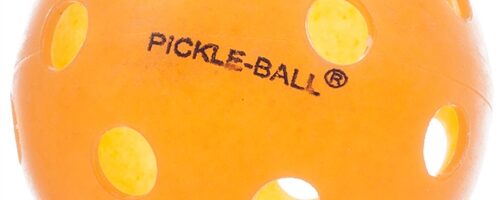
The Difference Between Different Pickleballs
I don’t know if you are aware of this, but there are actually several types of pickleball balls.
First things first, a pickleball ball is made of polymer materials with 40 holes in it, similar to a wiffleball. The diameter and weight of the ball may vary according to the type, ranging between 2.874 inches (73mm) and 2.972 inches (75.5mm) in diameter, and 0.78 ounces (22 grams) and 0.935 ounces (26.5 grams) in weight. It usually comes in three colors: white, orange, and the most popular, yellow.
You can play pickleball both indoor and outdoor. Thus, there’s a specific kind of ball appropriate for each court. This latest blog entry aims to identify the differences between an outdoor ball and indoor ball. In addition, there are now specially-modified balls that adapt well to the condition of both courts.
Outdoor Balls
The ball that is played in outdoor pickleball courts is thicker, bigger and heavier compared to an indoor ball.
Dura Fast 40, previously called Dura Fast 56, owns the bragging rights as the original pickleball and the heaviest ball in the market at one ounce. Like any other pickleball, it features 40 holes of varying sizes, enabling it to adapt the windy outdoor condition. Another outdoor ball widely used by pickleball players is the TOP Pickleball, which weighs 0.88 ounces and measures 2.9375 inches in diameter.
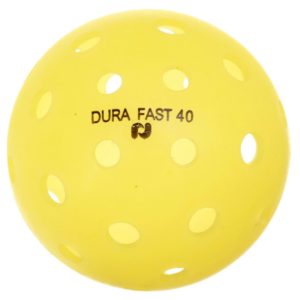
Onix Pickleball, manufactured by Onix Sports, just arrived in the market in 2013 but has steadily emerged into one of the most popular pickleball brands out there. It features a minor separation seam similar to TOP pickleball. However, what stands out in an Onix ball is its unique hole configuration and all holes are equal in sizes.
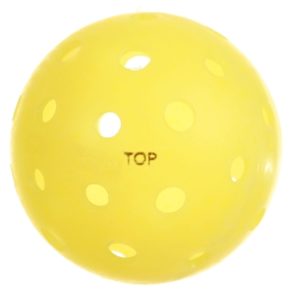
TOP, Dura, and Onix balls met the specifications set by the USA’s Pickleball Association and can be officially used in sanctioned tournaments.
Indoor Balls
Balls played indoor are generally smaller and a lot more buoyant.
The Jugs Pickleball, for example, earns the reputation for having a quirky bounce. It is made of soft plastic, making it one of the smallest (2.875 inches in diameter) and lightest ball (0.81 ounces) among outdoor and indoor pickleball balls. Jugs Pickleballs are only available in two colors: white and lime green.
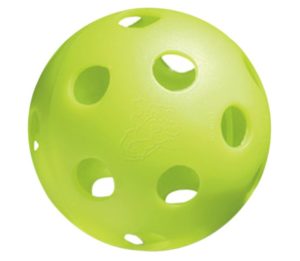
The Midnight Indoor Pickleball is Pickleballcentral’s version of the Taiwan-made Jugs Pickleball. The only difference is that these balls are available in darker colors (black, pink, and indigo blue). It weighs and measures exactly the same as Jugs Pickleball and also has a fun bounce.
Big Hole Dura Pickleball is basically the lightweight edition of the standard outdoor Dura Pickleball at 0.9 ounces. It features thicker walls for durability and bigger holes for a slower bounce. As a matter of fact, it’s the slowest pickleball out there, and that makes it very compatible for beginners and players who want to play at a slow pace.
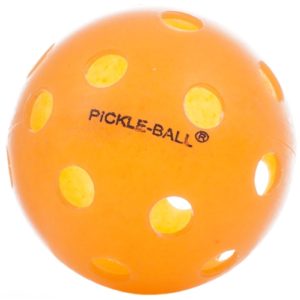
The Hybrid Ball – Onix QuiteBall
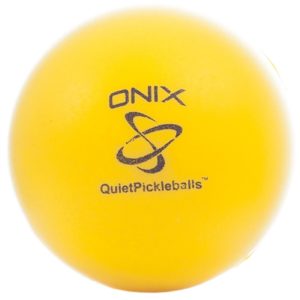
Onix introduced a few years ago its first hybrid pickleball – the QuiteBall. Although pickleballs are traditionally made of polymer materials, the Onix QuiteBall is made entirely of foam.
It’s the lightest (0.7 oz) and quietest pickleball, yet it bounces just as high as a standard pickleball. You can play with it in both indoor and outdoor courts.
The only drawback with this particular ball is it feels like you are playing soft tennis instead of pickleball. USA’s Pickleball Association doesn’t approve Onix Quiteball for tournament use, although you can still use it or recreational purposes.
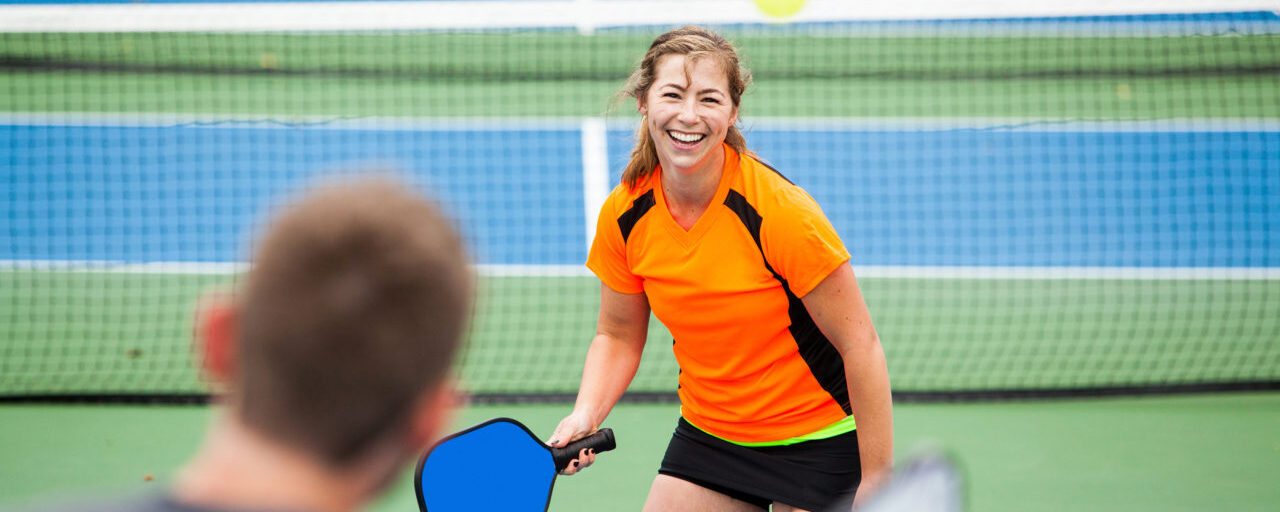
Guide to IFP Ratings
This content was last updated on November 25, 2017 using the official descriptions of the International Pickleball Federation.
| The IFP Rating System has been created to help describe differences in the various skill levels. | |
| Rating | Rating Description |
| 1.0 |
|
| 1.5 |
|
| 2.0 |
|
| 2.5 |
|
| 3.0 |
|
| 3.5 |
|
| 4.0 |
|
| 4.5 |
|
| 5.0 |
|


